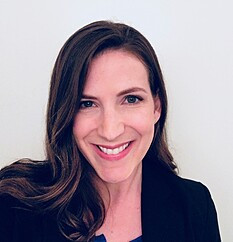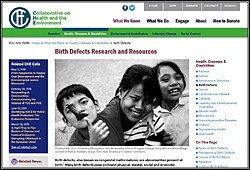Blog
Post category: air quality
2018
What’s new
Meet Our 20 Pioneers under 40 in Environmental Public Health: Samantha Rubright, DrPH, CPH
 Samantha Malone Rubright, DrPH, CPH is one member of a small, non-profit organization called FracTracker Alliance. The goal of FracTracker “is to help stakeholders understand oil and gas data so that they can make informed choices and affect protective policy decisions.”
Samantha Malone Rubright, DrPH, CPH is one member of a small, non-profit organization called FracTracker Alliance. The goal of FracTracker “is to help stakeholders understand oil and gas data so that they can make informed choices and affect protective policy decisions.”
“Hydraulic fracturing, or fracking as it is called, is just one part of drilling for oil and natural gas today. Fracking is a stimulation process that uses lots of water, injected at high pressure into the ground, along with chemicals and sand, to fracture the earth and bring the resources to the surface. Drillers use unconventional methods like fracking to extract oil and other hydrocarbons from underground because these resources are not in easily accessible pockets or reservoirs,” Dr. Rubright explains. . . .
2018
What’s new
Meet our 20 Pioneers under 40 in Environmental Public Health: Amy Padula, PhD, MSc
 Amy Padula, PhD, has devoted much of her work to looking at how the air we breathe can impact health.
Amy Padula, PhD, has devoted much of her work to looking at how the air we breathe can impact health.
“Most of my work has been focused on air pollution exposures during pregnancy and how it affects the baby,” Dr. Padula says.
Air pollution affects everyone, but she has a unique and interesting reason why her work has focused on women who are pregnant and their children.
“We look at pregnancy because it is the special time when there is a lot developing and a lot happening. As humans, we are very vulnerable during this period of development and, in a way, during pregnancy, babies can be considered canaries in a coal mine because they develop so fast that if there are adverse changes to their development, we are able to see them more quickly than, for example, increases in mortality over 60, 70, or 80 years,” Dr. Padula explains. . . .
2017
What’s new
New Pages: Asthma and Water Quality
CHE is excited to share that two more pages have been added this week: Asthma and Water Quality. The asthma page summarizes the science linking asthma to various environmental causes including air pollution, climate change, and community stressors. The Water Quality page lays out what health impacts have been associated with various water contaminants according to recent science. Both pages touch on tips for prevention.
2017
What’s new
Just released! Protecting Children’s Health Where They Live, Learn, and Play.
This report from the NIEHS/EPA Children’s Environmental Health and Disease Prevention Centers highlights some of the important contributions the centers have made toward reducing the burden of environmentally induced or exacerbated diseases placed on children. The report provides examples of success in the community and in support of public health. It is organized in three section:
- Health outcomes, presenting scientific findings from the Children’s Centers on diseases that sometimes affect children
- Environmental exposures, presenting research findings on chemicals and pollutants children are commonly exposed to through air, water and food.
- Hallmark features, highlighting the unique features that have facilitated the work of the Children’s Centers and advancements in the field.
2017
What’s new
New Pages: Cardiovascular Disease and Air Quality
CHE is proud to announce that two new webpages have been added to our website: Cardiovascular Disease Research and Resources and Air Quality. The Cardiovascular Disease page summarizes evidence connecting various cardiovascular diseases with environmental, lifestyle and medical risk factors. The Air Quality page lays out what research indicates are the health impacts of a variety of air pollutants. Sections on prevention conclude both pages.
2017
What’s new
HEAL Receives the 2017 Environmental Award
 The Bursa Chamber of Medicine, the official local branch of the Turkish Medical Association, awarded the 2017 Environmental Prize to CHE's Partner the Health and Environment Alliance (HEAL) during National Doctor's Day in Turkey. This award recognized HEAL's contribution to the resistance against the planned DOSAB coal power plant in Bursa. HEAL's figures on the health costs of air pollution associated with coal were used to challenge the official environmental impact assessment. Read the press release and view HEAL's report The Unpaid Health Bill, How coal power plants in Turkey make us sick. . . .
The Bursa Chamber of Medicine, the official local branch of the Turkish Medical Association, awarded the 2017 Environmental Prize to CHE's Partner the Health and Environment Alliance (HEAL) during National Doctor's Day in Turkey. This award recognized HEAL's contribution to the resistance against the planned DOSAB coal power plant in Bursa. HEAL's figures on the health costs of air pollution associated with coal were used to challenge the official environmental impact assessment. Read the press release and view HEAL's report The Unpaid Health Bill, How coal power plants in Turkey make us sick. . . .
2017
What’s new
New Webpage: Birth Defects
 Our new webpage offers an overview of exposures, prevalence, prevention strategies, economic impacts and ethical issues regarding birth defects. Find out more by viewing our web page today!
Our new webpage offers an overview of exposures, prevalence, prevention strategies, economic impacts and ethical issues regarding birth defects. Find out more by viewing our web page today!
2017
What’s new
Epigenetics and Environmental Health: A Short Educational Video
 Operating through epigenetic mechanisms, environmental exposures can get under our skin and affect our health. As new research comes forward shedding light on how the environment affects our epigenome, translating these findings to the broader public has been challenging. The University of Washington EDGE Center created a short animated video teaching the concept of epigenetics and how everyday exposures can alter gene expression and thus affect our health. View the video today. . . .
Operating through epigenetic mechanisms, environmental exposures can get under our skin and affect our health. As new research comes forward shedding light on how the environment affects our epigenome, translating these findings to the broader public has been challenging. The University of Washington EDGE Center created a short animated video teaching the concept of epigenetics and how everyday exposures can alter gene expression and thus affect our health. View the video today. . . .


